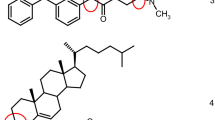Abstract
Chiral 1,1’-binaphthyl-linked diporphyrin ‘tweezers’ (R)-1/(S)-1 and the corresponding zinc(II) complexes (R)-2/(S)-2 were prepared as chiral host molecules, and their utility for chiral analyses (especially enantiomeric excess (ee) determinations) were evaluated. Tris(1-n-dodecyl)porphyrins were used for the first time as the interacting units. Host capabilities of the diporphyrin tweezers were investigated by titrations with (R,R)- and (S,S)-cyclohexane-1,2-diamine (CHDA). The host molecules could be used as multichannel probes of ee by using UV-vis, circular dichroism (CD), fluorescence emission and 1H nuclear magnetic resonance (1H-NMR) methods. Chiral configurations could also be differentiated using CD or 1H-NMR spectroscopy. All three optical techniques give good resolution of ee with reasonable sensitivity considering the low concentrations used (ca. 10−6 mol·L−1). The ee determination of CHDA enantiomers using NMR spectroscopy is also possible because of the reasonably well separated resonances in the case of (R,R)- and (S,S)-CHDA. Non-metallated (R)-1/(S)-1 hosts could not be used to detect chiral information in a strongly acidic chiral guest. This work demonstrates the utility of 1,1’-binapthyl-linked chiral hosts for chiral analysis of ditopically interacting enantiomers.

Similar content being viewed by others
References
Nunez M D C, Gallo M A, Espinosa A, Campos J M. Rapid development of chiral drugs in the pharmaceutical industry. In: New Developments in Medicinal Chemistry. United Arab Emirates: Bentham Science Publishers, 2010, 95–113
Lehn J M. Supramolecular Chemistry: Concepts and Perspectives. Weinheim, Germany: Wiley-VCH Verlagsgesellschaft, 1995, 1–271
Halpern J, Trost B. Asymmetric catalysis. Proceedings of the National Academy of Sciences of the United States of America, 2004, 101(15): 5347
Okamoto Y, Ikai T. Chiral HPLC for efficient resolution of enantiomers. Chemical Society Reviews, 2008, 37(12): 2593–2608
Parker D. NMR determination of enantiomeric purity. Chemical Reviews, 1991, 91(7): 1441–1457
Shcherbakova E G, Brega V, Lynch V M, James T D, Anzenbacher P Jr. High-throughput assay for enantiomeric excess determination in 1,2- and 1,3-diols and direct asymmetric reaction screening. Chemistry (Weinheim an der Bergstrasse, Germany), 2017, 23(42): 10222–10229
Jo H H, Lin C Y, Anslyn E V. Rapid optical methods for enantiomeric excess analysis: From enantioselective indicator displacement assays to exciton-coupled circular dichroism. Accounts of Chemical Research, 2014, 47(7): 2212–2221
Yang L, Wenzel T, Williamson R T, Christensen M, Schafer W, Welch C J. Expedited selection of NMR chiral solvating agents for determination of enantiopurity. ACS Central Science, 2016, 2(5): 332–340
Pirkle W H, Sikkenka D L. The use of chiral solvating agent for nuclear magnetic resonance determination of enantiomeric purity and absolute configuration of lactones: Consequences of three-point interactions. Journal of Organic Chemistry, 1977, 42(8): 1370–1374
Labuta J, Ishihara S, Šikorský T, Futera Z, Shundo A, Hanyková L, Burda J V, Ariga K, Hill J P. NMR spectroscopic detection of chirality and enantiopurity in referenced systems without formation of diastereomers. Nature Communications, 2013, 4(1): 2188
Labuta J, Hill J P, Ishihara S, Hanyková L, Ariga K. Chiral sensing by nonchiral tetrapyrroles. Accounts of Chemical Research, 2015, 48(3): 521–529
Kadish K M, Smith K M, Guilard R, eds. The Porphyrin Handbook. San Diego: Academic Press, 2003, 1–20
Sreenilayam G, Moore E J, Steck V, Fasan R. Stereoselective olefin cyclopropanation under aerobic conditions with an artificial enzyme incorporating an iron-chlorin e6 cofactor. ACS Catalysis, 2017, 7(11): 7629–7633
Nandipati V, Akinapelli K, Koya L, Starnes S D. Recognition of mandelate stereoisomers by chiral porphyrin hosts: Prediction of stereopreference in guest binding a priori using a simple binding model. Tetrahedron Letters, 2014, 55(5): 985–991
Ema Y, Nemugaki S, Tsuboi S, Utaka M. Synthesis and CD spectrum of chiral porphyrin dimer. Tetrahedron Letters, 1995, 36(33): 5905–5908
Hayashi T, Nonoguchi M, Aya T, Ogoshi H. Molecular recognition of α,ω-diamines by metalloporphyrin dimer. Tetrahedron Letters, 1997, 38(9): 1603–1606
Kurtán T, Nesnas N, Li Y Q, Huang X, Nakanishi K, Berova N. Chiral recognition by CD-sensitive dimeric zinc porphyrin host. 1. Chiroptical protocol for absolute configurational assignments of monoalcohols and primary monoamines. Journal of the American Chemical Society, 2001, 123(25): 5962–5973
Borovkov V V, Fujii I, Muranaka A, Hembury G A, Tanaka T, Ceulemans A, Kobayashi N, Inoue Y. Rationalization of supramolecular chirality in a bisporphyrin system. Angewandte Chemie International Edition, 2004, 43(41): 5481–5485
Saha B, Ikbal S A, Petrovic A G, Berova N, Rath S P. Complexation of chiral zinc-porphyrin tweezer with achiral diamines: Induction and two-step inversion of interporphyrin helicity monitored by ECD. Inorganic Chemistry, 2017, 56(7): 3849–3860
Liu G, Yasumitsu T, Zhao L, Peng X, Wang F, Bauri A K, Aonuma S, Kimura T, Komatsu N. Preferential extraction of left- and right-handed single-walled carbon nanotubes by use of chiral diporphyrin nanotweezers. Organic & Biomolecular Chemistry, 2012, 10(30): 5830–5836
Labuta J, Ishihara S, Shundo A, Arai S, Takeoka S, Ariga K, Hill J P. Chirality sensing by non-chiral porphines. Chemistry (Weinheim an der Bergstrasse, Germany), 2011, 17(13): 3558–3561
Ishihara S, Labuta J, Futera Z, Mori S, Sato H, Ariga K, Hill J P. NMR spectroscopic determination of enantiomeric excess using small prochiral molecules: Intermolecular transfer of magnetic anisotropy in isotropic media. Journal of Physical Chemistry B, 2018, 122(19): 5114–5120
Shinoda T, Onaka M, Izumi Y. The reason why K10 is an effective promoter for meso-tetraalkylporphyrin synthesis. Chemistry Letters, 1995, 24(7): 493–494
Plamont R, Kikkawa Y, Takahashi M, Kanesato M, Giorgi M, Shun A C K, Roussel C, Balaban T S. Nanoscopic imaging of mesotetraalkylporphyrins prepared in high yields enabled by Montmorillonite K10 and 3 Å molecular sieves. Chemistry (Weinheim an der Bergstrasse, Germany), 2013, 19(34): 11293–11300
Rostami M, Rafiee L, Hassanzadeh F, Dadrass A R, Khodarahmi G A. Synthesis of some new porphyrins and their metalloderivatives as potential sensitizers in photo-dynamic therapy. Research in Pharmaceutical Sciences, 2015, 10(6): 504–513
Connors K A. Binding Constants: The Measurement of Molecular Complex Stability. New York: Wiley-Interscience, 1987, 1–432
Hirose K. A practical guide for the determination of binding constants. Journal of Inclusion Phenomena and Macrocyclic Chemistry, 2001, 39(3–4): 193–209
Henry E R, Hofrichter J. Methods in Enzymology. London: Academic Press, 1992, 210: 29–192
Malinowski E R. Factor Analysis in Chemistry. New York: Wiley-Interscience, 2002, 1–432
Březina V, Ishihara S, Lang J, Hanyková L, Ariga K, Hill J P, Labuta J. Structural modulation of chromic response: Effects of binding-site blocking in a conjugated calix[4]pyrrole chromophore. ChemistryOpen, 2018, 7(5): 323–335
Hanuš J, Chmelová K, Štěpánek J, Turpin P Y, Bok J, Rosenberg I, Točík Z. Raman spectroscopic study of triplex-like complexes of polyuridylic acid with the isopolar, non-isosteric phosphonate analogues of diadenosine monophosphate. Journal of Raman Spectroscopy, 1999, 30(8): 667–676
Zimányi L. Analysis of the bacteriorhodopsin photocycle by singular value decomposition with self-modeling: A critical evaluation using realistic simulated data. Journal of Physical Chemistry B, 2004, 108(13): 4199–4209
Zimányi L, Kulcsár Á, Lanyi J K, Sears D F, Saltiel J. Singular value decomposition with self-modeling applied to determine bacteriorhodopsin intermediate spectra: Analysis of simulated data. Proceedings of the National Academy of Sciences of the United States of America, 1999, 96(8): 4408–4413
Brahma S, Ikbal S A, Dhamija A, Rath S P. Highly enhanced bisignate circular dichroism of ferrocene-bridged Zn(II) bisporphyrin tweezer with extended chiral substrates due to well-matched host-guest system. Inorganic Chemistry, 2014, 53(5): 2381–2395
Brahma S, Ikbal S A, Rath S P. Synthesis, structure, and properties of a series of chiral tweezer-diamine complexes consisting of an achiral zinc(II) bisporphyrin host and chiral diamine guest: Induction and rationalization of supramolecular chirality. Inorganic Chemistry, 2014, 53(1): 49–62
Zhang P, Wolf C. Sensing of the concentration and enantiomeric excess of chiral compounds with tropos ligand derived metal complexes. Chemical Communications, 2013, 49(62): 7010–7012
Jung S H, Kim K Y, Ahn A, Lee S S, Choi M Y, Jaworski J, Jung J W. NMR detection of chirality and enantiopurity of amines by using benzene tricarboxamide-based hydrogelators as chiral solvating agents. New Journal of Chemistry, 2016, 40(9): 7917–7922
Wang C, Wu X, Pu L. A highly fluorescent chiral aldehyde for enantioselective fluorescent recognition in a biphasic system. Chemistry (Weinheim an der Bergstrasse, Germany), 2017, 23(45): 10749–10752
Zardi P, Wurst K, Licini G, Zonta C. Concentration-independent stereodynamic g-Probe for chiroptical enantiomeric excess determination. Journal of the American Chemical Society, 2017, 139(44): 15616–15619
Ema T, Ouchi N, Doi T, Korenaga T, Sakai T. Highly sensitive chiral shift reagent bearing two zinc porphyrins. Organic Letters, 2005, 7(18): 3985–3988
Ema T, Misawa S, Nemugaki S, Sakai T, Utaka M. New optically active diporphyrin having a chiral cyclophane as a spacer. Chemistry Letters, 1997, 26(6): 487–488
Borovkov V V, Lintuluoto J M, Hembury G A, Sugiura M, Arakawa R, Inoue Y. Supramolecular chirogenesis in zinc porphyrins: Interaction with bidentate ligands, formation of tweezer structures, and the origin of enhanced optical activity. Journal of Organic Chemistry, 2003, 68(19): 7176–7192
Chen Q, Hirsch R E. A direct and simultaneous detection of zinc protoporphyrin IX, free protoporphyrin IX, and fluorescent heme degradation product in red blood cell hemosylates. Free Radical Research, 2006, 40(3): 285–294
Fossey J S, Anslyn E V, Brittain W D G, Bull S D, Chapin B M, Le Duff C L, James T D, Lees G, Lim S, Lloyd J A C, et al. Rapid determination of enantiomeric excess via NMR spectroscopy: A research-informed experiment. Journal of Chemical Education, 2017, 94(1): 79–84
Berova N, Pescitelli G, Petrovic A G, Proni G. Probing molecular chirality by CD-sensitive dimeric metalloporphyrin hosts. Chemical Communications, 2009, 40(40): 5958–5980
Tanasova M, Anyika M, Borhan B. Sensing remote chirality: Stereochemical determination of β, γ, and δ-chiral carboxylic acids. Angewandte Chemie International Edition, 2015, 54(14): 4274–4278
Lu W, Yang H, Li X, Wang C, Zhan X, Qi D, Bian Y, Jiang J. Chiral discrimination of diamines by a binaphthylene-bridged porphyrin dimer. Inorganic Chemistry, 2017, 56(14): 8223–8231
Payne D T, Fossey J S, Elmes R B P. Catalysis and sensing for our environment (CASE2015) and the supramolecular chemistry Ireland meeting (SCI 2015): Dublin and Maynooth, Ireland. 8th-11th July. Supramolecular Chemistry, 2016, 28(11–12): 921–931
Acknowledgements
This work was partly supported by World Premier International Research Center Initiative, MEXT, Japan. The authors are grateful to Japan Society for the Promotion of Science (JSPS) for a JSPS Fellowship (to D.T.P.). This work was also partially supported by JSPS KAKENHI (Coordination Asymmetry) Grant No. JP16H06518, JSPS KAKENHI Grant No. 19K05229 and CREST, JST Grant No. JPMJCR1665. This work was partly financially supported by the National Science Foundation (Grant No. 1401188 to FD). The authors thank the Catalysis and Sensing for our Environment network for essential networking opportunities [48].
Author information
Authors and Affiliations
Corresponding authors
Supplementary Information
Rights and permissions
About this article
Cite this article
Payne, D.T., Chahal, M.K., Březina, V. et al. Diporphyrin tweezer for multichannel spectroscopic analysis of enantiomeric excess. Front. Chem. Sci. Eng. 14, 28–40 (2020). https://doi.org/10.1007/s11705-019-1869-1
Received:
Accepted:
Published:
Issue Date:
DOI: https://doi.org/10.1007/s11705-019-1869-1




